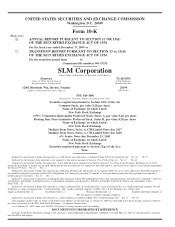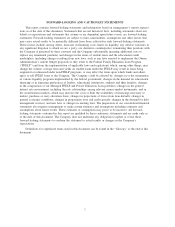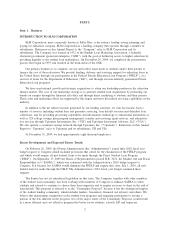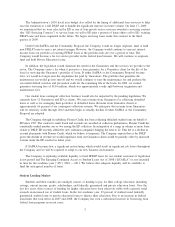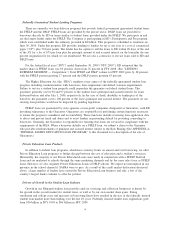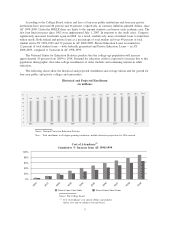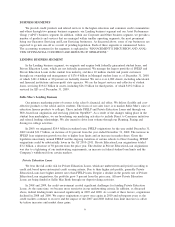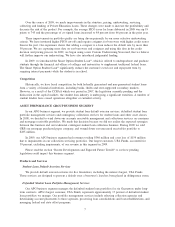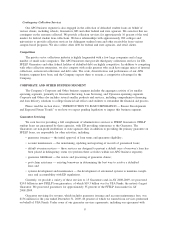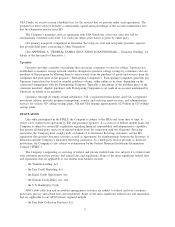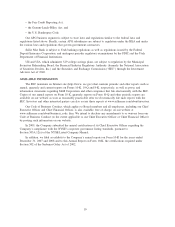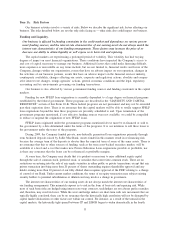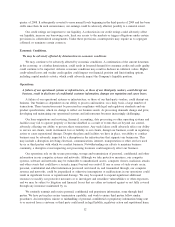Sallie Mae 2009 Annual Report Download - page 3
Download and view the complete annual report
Please find page 3 of the 2009 Sallie Mae annual report below. You can navigate through the pages in the report by either clicking on the pages listed below, or by using the keyword search tool below to find specific information within the annual report.PART I.
Item 1. Business
INTRODUCTION TO SLM CORPORATION
SLM Corporation, more commonly known as Sallie Mae, is the nation’s leading saving, planning and
paying for education company. SLM Corporation is a holding company that operates through a number of
subsidiaries. References in this Annual Report to the “Company” refer to SLM Corporation and its
subsidiaries. The Company was formed in 1972 as the Student Loan Marketing Association, a federally
chartered government sponsored enterprise (“GSE”), with the goal of furthering access to higher education by
providing liquidity to the student loan marketplace. On December 29, 2004, we completed the privatization
process that began in 1997 and resulted in the wind-down of the GSE.
Our primary business is to originate, service and collect loans made to students and/or their parents to
finance the cost of their education. We provide funding, delivery and servicing support for education loans in
the United States through our participation in the Federal Family Education Loan Program (“FFELP”), as a
servicer of loans for the Department of Education (“ED”), and through our non-federally guaranteed Private
Education Loan programs.
We have used internal growth and strategic acquisitions to attain our leadership position in the education
finance market. The core of our marketing strategy is to generate student loan originations by promoting our
brands on campus through the financial aid office and through direct marketing to students and their parents.
These sales and marketing efforts are supported by the largest and most diversified servicing capabilities in the
industry.
In addition to the net interest income generated by our lending activities, we earn fee income from a
number of services including student loan and guarantee servicing, loan default aversion and defaulted loan
collections, and for providing processing capabilities and information technology to educational institutions as
well as 529 college savings plan program management, transfer and servicing agent services, and administra-
tive services through Upromise Investments, Inc. (“UII”) and Upromise Investment Advisors, LLC (“UIA”).
We also operate a consumer savings network through Upromise, Inc. (“Upromise”). References in this Annual
Report to “Upromise” refer to Upromise and its subsidiaries, UII and UIA.
At December 31, 2009, we had approximately eight thousand employees.
Recent Developments and Expected Future Trends
On February 26, 2009, the Obama Administration (the “Administration”) issued their 2010 fiscal year
budget request to Congress which included provisions that called for the elimination of the FFELP program
and which would require all new federal loans to be made through the Direct Student Loan Program
(“DSLP”). On September 17, 2009 the House of Representatives passed H.R. 3221, the Student Aid and Fiscal
Responsibility act (“SAFRA”), which was consistent with the Administration’s 2010 budget request to
Congress. If it became law SAFRA would eliminate the FFELP and require that, after July 1, 2010, all new
federal loans be made through the DSLP. The Administration’s 2011 fiscal year budget continued these
requests.
The Senate has not yet introduced legislation on this issue. The Company, together with other members
of the student loan community, has been working with members of Congress to enhance SAFRA to allow
students and schools to continue to choose their loan originator and to require servicers to share in the risk of
loan default. This proposal is referred to as the “Community Proposal” because it has the widespread support
of the student lending community, which includes lenders, Guarantors, financial aid advisors and others. We
believe that maintaining competition in the student loan programs and requiring participants to assume a
portion of the risk inherent in the program, two of the major tenets of the Community Proposal, would result
in a more efficient and cost effective program that better serves students, schools, ED and taxpayers.
2

